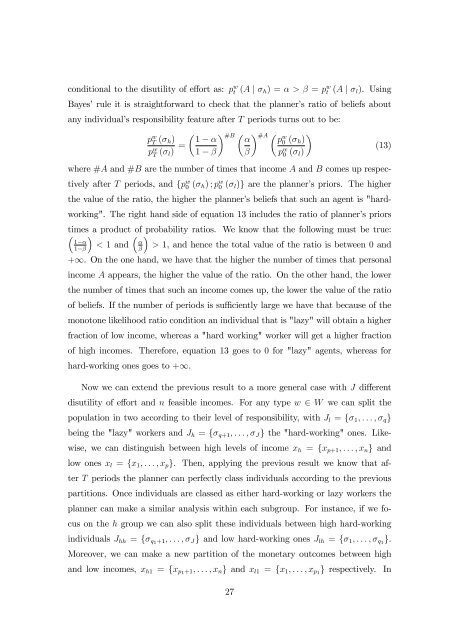You also want an ePaper? Increase the reach of your titles
YUMPU automatically turns print PDFs into web optimized ePapers that Google loves.
conditional to the disutility of e¤ort as: p w t (A j h ) = > = p w t (A j l ). Usi<strong>ng</strong><br />
Bayes’rule it is straightforward to check that the planner’s ratio of beliefs about<br />
any individual’s responsibility feature after T periods turns out to be:<br />
p w T ( #B #A <br />
h) 1 p<br />
w<br />
p w T ( l) = 0 ( h )<br />
1 p w 0 ( l )<br />
where #A and #B are the number of times that income A and B comes up respectively<br />
after T periods, and fp w 0 ( h ) ; p w 0 ( l )g are the planner’s priors. The higher<br />
the value of the ratio, the higher the planner’s beliefs that such an agent is "hardw<stro<strong>ng</strong>>orki<strong>ng</strong></stro<strong>ng</strong>>".<br />
The right hand side of equation 13 includes the ratio of planner’s priors<br />
times a product of probability ratios. We know that the followi<strong>ng</strong> must be true:<br />
<br />
< 1 and > 1, and hence the total value of the ratio is between 0 and<br />
1 <br />
1 <br />
<br />
<br />
+1. On the one hand, we have that the higher the number of times that personal<br />
income A appears, the higher the value of the ratio. On the other hand, the lower<br />
the number of times that such an income comes up, the lower the value of the ratio<br />
of beliefs. If the number of periods is su¢ ciently large we have that because of the<br />
monotone likelihood ratio condition an individual that is "lazy" will obtain a higher<br />
fraction of low income, whereas a "hard w<stro<strong>ng</strong>>orki<strong>ng</strong></stro<strong>ng</strong>>" worker will get a higher fraction<br />
of high incomes. Therefore, equation 13 goes to 0 for "lazy" agents, whereas for<br />
hard-w<stro<strong>ng</strong>>orki<strong>ng</strong></stro<strong>ng</strong>> ones goes to +1.<br />
(13)<br />
Now we can extend the previous result to a more general case with J di¤erent<br />
disutility of e¤ort and n feasible incomes. For any type w 2 W we can split the<br />
population in two accordi<strong>ng</strong> to their level of responsibility, with J l = f 1 ; : : : ; q g<br />
bei<strong>ng</strong> the "lazy" workers and J h = f q+1 ; : : : ; J g the "hard-w<stro<strong>ng</strong>>orki<strong>ng</strong></stro<strong>ng</strong>>" ones. Likewise,<br />
we can disti<strong>ng</strong>uish between high levels of income x h<br />
= fx p+1 ; : : : ; x n g and<br />
low ones x l = fx 1 ; : : : ; x p g. Then, applyi<strong>ng</strong> the previous result we know that after<br />
T periods the planner can perfectly class individuals accordi<strong>ng</strong> to the previous<br />
partitions. Once individuals are classed as either hard-w<stro<strong>ng</strong>>orki<strong>ng</strong></stro<strong>ng</strong>> or lazy workers the<br />
planner can make a similar analysis within each subgroup. For instance, if we focus<br />
on the h group we can also split these individuals between high hard-w<stro<strong>ng</strong>>orki<strong>ng</strong></stro<strong>ng</strong>><br />
individuals J hh = f q1 +1; : : : ; J g and low hard-w<stro<strong>ng</strong>>orki<strong>ng</strong></stro<strong>ng</strong>> ones J lh = f 1 ; : : : ; q1 g.<br />
Moreover, we can make a new partition of the monetary outcomes between high<br />
and low incomes, x h1 = fx p1 +1; : : : ; x n g and x l1 = fx 1 ; : : : ; x p1 g respectively. In<br />
27

















